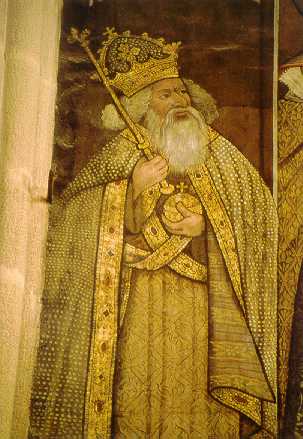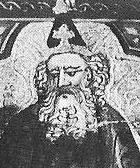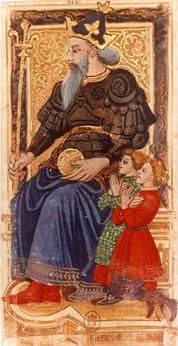That's the coat of Arms of Bohemia. The presented crown has few leaves only and the top is a cross.
I guess, that's our real object.
The Hungarian crown (Sigismund was king of Hungary first) is totally different:
http://en.wikipedia.org/wiki/Crown_of_St._Stephen
The German Empire crown (Sigismund was NOT Emperor at the council)
... totally different.
******
And here the picture turns clear
http://www.viewimages.com/Search.aspx?mid=51244915&epmid=1&partner=Google
King Wenzel crown ... without cross, but with another top, in the council's time still living in concurrence to Sigismund. So Sigismund's crown (with cross) should be a counter-crown against Wenzel.
The older Bohemian crown (ca. 1300) had few leaves, but no top:
http://www.viewimages.com/Search.aspx?mid=51244404&epmid=1&partner=Google
as far we can rely on these pictures, which surely are made long after the time.
The actual German history was this:
1378: Emperor Charles IV (also King of Bohemia) died.
1378: His son Wenzel follows him as German King and King of Bohemia.
1400: King Wenzel is abdicted - as emperor.
1400: King Ruprecht reigns from 1400 - 1410. He dies.
1410-1411, Jobst of Maehren. He dies.
1411: Sigismund, King of Hungary and brother of Wenzel, becomes German King ... actually he's now the
fourth King of the same generation.
and here a side-view on the rules of
Karnöffel, also called Kaiser-game or Imperatori.
There are 4 Kaiser (or could-be-Kaiser), which overrule each other, in the game these are the trump-2, the trump-3, the trump-4 and trump-5. Additionally there are the Pope (trump-6) and the devil (trump-7) and the Karnöffel, who beats them all.
... back to history. Sigismund is in conflict with Wenzel, still king of Bohemia. The conflict between them is obvious in the person of Johann Hus, who is invited from Bohemia, promised "diplomatic status" and against the promises burnt at the stake in 1415. Beside the abdiction of three popes this is the most central story of the council of Constance.
1378: Emperor Charles VI died
1378: The Schisma of the church started
1415 (in the intention of the council): the "good king" Sigismund replaces the "wrong king" King Wenzel - also in Bohemia.
1415 (in the intention of the council): The Schisma is overcome.
This was the historical hope of the council and the political intention of the time. King Wenzel agreed, but the Bohemians disagreed and this disagreement endured many decades with various steps of peace and war.
Specifically Wenzel, who had tried to play the role of German king again in 1410, had agreed in 1411 to Sigismund, who had promised to make him Emperor (never realised). Wenzel kept the title of the German king, though this was a meaningless name.
Sigismund himself had the promise from Wenzel to become heir of Bohemia.
During the council Wenzel was protected by Sigismund against his aggressors.
But Wenzel himself was urged by his brother to work against the rebellish Bohemians. When the conflict was strengthened in 1419, he died.
Sigismund became then the king of Bohemia, but it took long time before he was accepted in Bohemia.
Nonetheless: the relevant crown seems to be that of Bohemia or a variation of it ... perhaps his role as exspected heir of Bohemia also was related to a specific crown already at the council.
One has to see, that the crown of Bohemia was in Sigismunds time long connected to the Empire crown ... (since 1307) so it had possibly a crucial "symbolic role" in the mind of the time. As theme of the council Bohemia (Jan Hus) was generally focussed.
***
Btw. The Polish crown (which seems to have changed often) has similarties to the Bohemian crown (once Poland and Bohemia were united for a short while)
A 14th century crown had also few great leaves , but no top. It was found fond in 19th century in the burial place, so it's the true crown:












